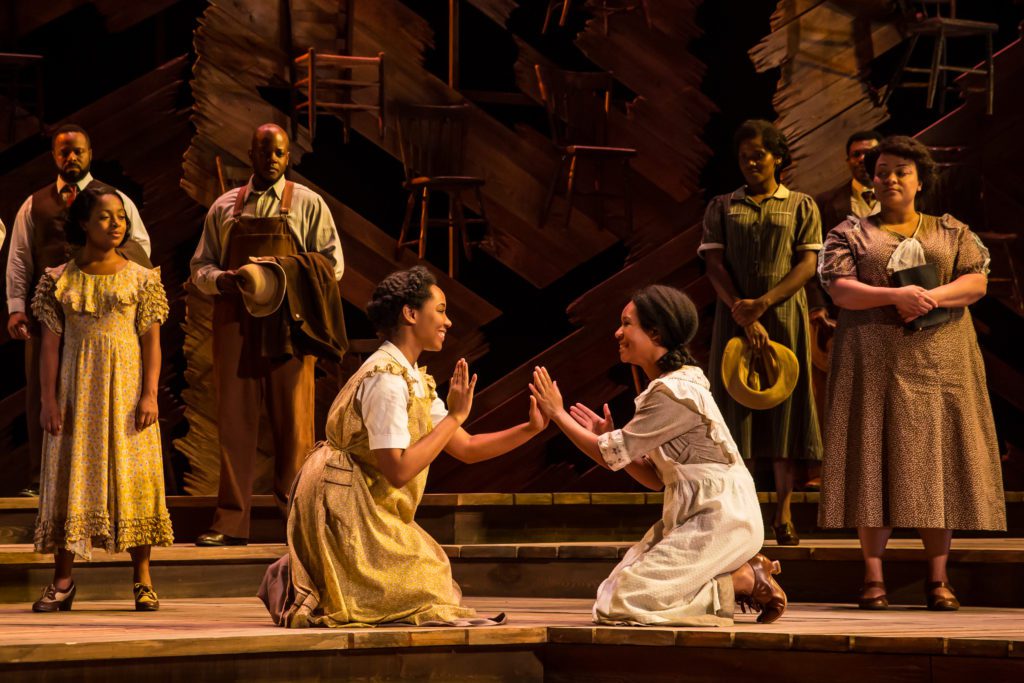A Rich ‘Color Purple’ at the Kennedy Center
By • August 16, 2018 0 846

Audiences can be odd entities. They can be fickle, nervous, uncommonly quiet in a good way and uncommonly silent in a cold way. They can be enthusiastic, loud, unreadable or open as a welcome mat.
It depends. For a play, be it musical or cutting-edge modern, Arthur Miller serious or Marx Brothers hilarious, you never know what will happen, what the audience can do for you or undo for you. It’s a force, faces in the dark who have the power to change everything.
Take “The Color Purple,” the musical revival — honored or burdened with expectations with a Tony for best Broadway revival — of Alice Walker’s riveting novel about the trials, travails and triumphs of Celie, a much-abused and long-suffering young African American woman growing up and emerging strong in the hardscrabble American South of the 1930s.
At a recent Sunday-afternoon performance by the national touring company in the Kennedy Center Eisenhower Theater (during which, coincidentally, a trifling number of white supremacists were making their way to demonstrate in Lafayette Square), the audience seemed to have a significant role, in fact, seemed to reflect the proceedings on the stage.
When the cast of African American men and women made their way to the stage, dominated by Tony Award winner John Doyle’s modernistic set of a staggered pyramid of chairs, they eyed the audience members in the front seats with eager greetings and invitations, sometimes waving hellos. At that point, they didn’t get much back.
Not yet.
That changed during the course of the two-hour-plus performance, slowly, but eventually triumphantly: a significant roll of applause for a song here, knowing rumbles of agreement during the sexy singer Snug Avery’s “Push the Button” or Sofia’s defiant “Hell No” or Celie’s growing affinity for empathy and growth as a woman and person.
You could see it all over the audience — lots of head nodding, the laughter of experience, the emotionality surging through groups of people. This was a racially mixed audience for whom the words and the songs might fall with different meanings and reactions, but which came together about the time that Celie recognizes her own power to control her own life and affect (and accept) others.
Some of the differences can be accounted for by racial, cultural and gender issues, but, after a while, as the show courses on its journey, it reaches points that become recognizably universal. You don’t have to be Celie or Sofia or Shug to embrace and recognize the bottomless afflictions and also gritty joys in the blues, or to be inspired by grassroots spirituals and gospel.
But it’s Celie, whom we see first used as chattel, reluctantly and brutally married to a husband named Mister, losing her children and her beloved sister, but rising above everything by not accepting her lot, and bringing the people who live in her world — and who sometimes belittle her, often love her — with her. Celie isn’t exactly overpowering; she’s a woman who embraces not the conditions of her life but how she can live and love deeply within that framework.
It takes newcomer Adrianna Hicks to accomplish that transition, for her Celie and for the audience. She’s hesitant at first, her voice sharp and clear, both in spoken words and song, then ever more embracing, soaring, until “The Color Purple” becomes a story of triumph, redemption, reunion and recognition in the climaxing title song and Celie’s show-stopping “I’m Here,” an anthem if there ever was one.
It takes a village to make this journey work. It takes the redemptive “Celie’s Curse,” sung by a powerful and abject Mister, played by Gavin Gregory. It takes a beguiling and strong performance by Carla Stewart as Avery, the charismatic, earthy, jazz and club singer, who can go from the sexually cavortive, Bessie Smith-style “Push the Button” to the tender “Too Beautiful for Words.” And it takes Carrie Compere, who dominates the stage as the defiant Sofia.
Running through Aug. 26 at the Kennedy Center, “The Color Purple” has a strong cast and strong music, which overcome a dearth of physical stagecraft by going to the heart of character, situation and emotion, in which there is no hidden language, no downplaying. It’s stark in setting but rich in feeling, which, by show’s end, is totally and vocally shared and embraced by the audience.

